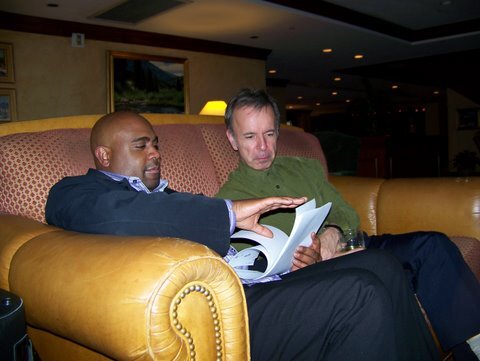The “fourth Stream . . . La Banda”
Terell Stafford and I have been good friends and musical compatriots for over ten years. He asked me a year or so ago to write something for him to play with his quartet and the Temple University Symphony, something classical, but jazz as well.
It’s tough to make jazz work with a symphony, seeing as the swing 8th notes feel entirely different than the straight ones you have with an orchestra.
But in Latin/salsa/Cuban/Mexican music, this is not a problem, as the 8th notes are straight there, too. Maybe that’s why Latin jazz and classical music work so well together, thinking about the Gershwin Cuban Overture, and Copland’s El Salon Mexico. And, of course, Paquito D’Rivera.
So I decided to do something in the salsa vein, but integrating it firmly with classical music, which was always my first love. The symphony orchestra is my favorite instrument.
I had been ruminating for, oh, maybe four or five years, about doing something on John Lewis’ “Django.” Now if you use his melody, it’s an arrangement, but if you just use a general example of his harmonic outline, then that’s a composition. And I wanted to really do something substantial that expresses a wide range of my interests.
So I decided to write a passacaglia, or bassline, on the harmonic pattern of “Django,” and write a set of variations on that, in the spirit of the Rachmaninoff Rhapsody on a Theme of Paganini, or the Elgar Enigma Variations. The Elgar particularly intrigued me because the theme is often hidden.
As I wrote the passacagla, a simple hymn-like tune in 3/4, I thought I could do so many things with it. We could “blow” on the changes with the jazz band. I could do a free fantasia based on the first few notes. I could construct a 12-tone row based on the rhythm of the passacagia.
And in a stroke of genius (Rachmaninoff’s, not mine!), I took the theme, turned it upside down, and a really nice tune emerged. As the piece progresses, the variations get less segmented, and kind of blur together, in a mad rush of energy, kind of, I hope, like the Elgar.
And I went “back to school,” taking a few lessons with composer/arrangers Del Hake and Ira Hearshen to brush up on my orchestration. Ira, in particular, was very helpful in advanced orchestration techniques, like creating aleatoric, atonal string washes, and blending instruments together in interesting ways.
Temple University's Terell Stafford
The dean of the Temple Boyer College of Music and Dance, Robert Stroker, told me, “Bill, this piece is finishing off the first half, so, whatever you do, make it loud!” So I called for a huge percussion section (it’s great, I ask them for stuff and I get it!!) to play one of the variations, and then join the orchestra in the last variation to “finish off” the piece. And, we pray.
It’s so great to work with a fine music school like this . . . they get the music way in advance, they put in lots of rehearsal time, and they’ve invited me to Philadelphia to listen to it, and maybe fix a few things a few weeks in advance.
They asked me for 15 to 20 minutes, and it times out at 25. Hopefully, they got their money’s worth!

